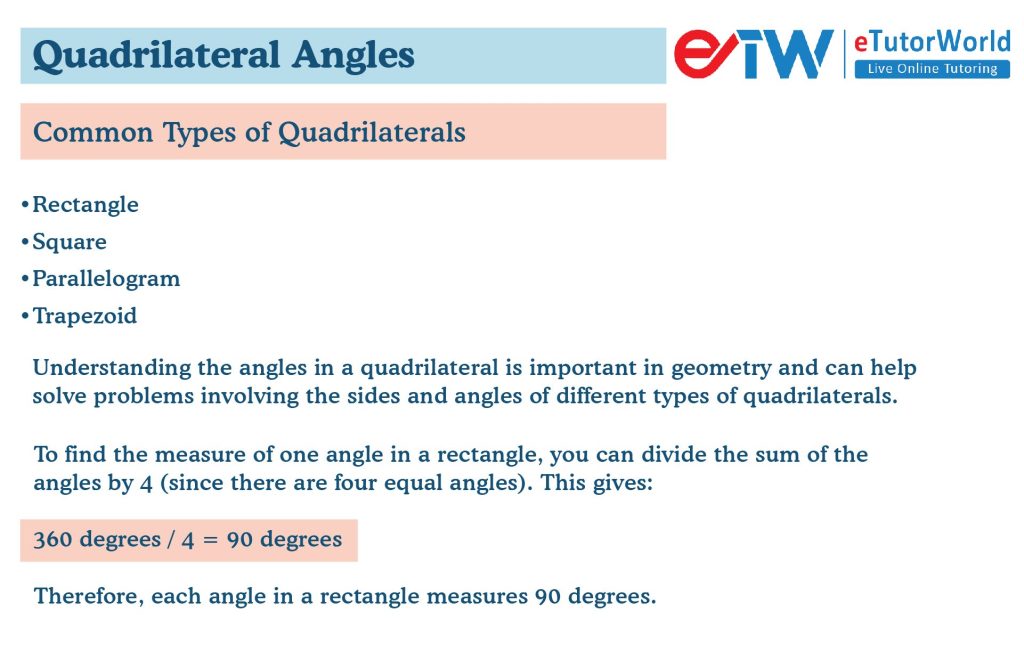Quadrilateral Angles
Grade 7 Math Worksheets
A quadrilateral is a polygon with four sides and four angles. The sum of the angles in a quadrilateral is always 360 degrees, which means that the four angles in a quadrilateral must add up to 360 degrees.
Table of Contents:
- Quadrilateral Angles
- Quadilateral Angles in Rectangle
- Quadilateral Angles in Square
- Quadilateral Angles in Parallelogram
- Quadilateral Angles in Trapezoid
- Solved Examples
- FAQs
Personalized Online Tutoring
Quadrilateral Angles - Grade 7 Math Worksheet PDF
This is a free worksheet with practice problems and answers. You can also work on it online.
Sign up with your email ID to access this free worksheet.
"We really love eTutorWorld!"
"We really love etutorworld!. Anand S and Pooja are excellent math teachers and are quick to respond with requests to tutor on any math topic!" - Kieran Y (via TrustSpot.io)
"My daughter gets distracted easily"
"My daughter gets distracted very easily and Ms. Medini and other teachers were patient with her and redirected her back to the courses.
With the help of Etutorworld, my daughter has been now selected in the Gifted and Talented Program for the school district"
- Nivea Sharma (via TrustSpot.io)
Quadrilateral Angles
A quadrilateral is a polygon with four sides and four angles. The sum of the angles in a quadrilateral is always 360 degrees, which means that the four angles in a quadrilateral must add up to 360 degrees.
The four angles in a quadrilateral can vary in size and measure.
Some common types of quadrilaterals include:
1. Rectangle: A rectangle is a quadrilateral with four right angles. Since a right angle measures 90 degrees, the sum of the four angles in a rectangle is 360 degrees, and each angle measures 90 degrees.
2. Square: A square is a quadrilateral with four equal sides and four right angles. Since each angle in a square measures 90 degrees, the sum of the four angles is 360 degrees, and each angle measures 90 degrees.
3. Parallelogram: A parallelogram is a quadrilateral with opposite sides that are parallel and equal in length. The opposite angles in a parallelogram are congruent (i.e., they have the same measure), so the sum of any pair of opposite angles is 180 degrees.
4. Trapezoid: A trapezoid is a quadrilateral with one pair of parallel sides. The sum of the two non-parallel angles in a trapezoid is always equal to the difference between the measures of the parallel angles.

Understanding the angles in a quadrilateral is important in geometry and can help solve problems involving the sides and angles of different types of quadrilaterals.
Quadilateral Angles in Rectangle
In a rectangle, all four angles are right angles (measuring 90 degrees). Since there are four angles in a rectangle, the sum of the angles is 360 degrees.
To find the measure of one angle in a rectangle, you can divide the sum of the angles by 4 (since there are four equal angles). This gives:
360 degrees / 4 = 90 degrees
Therefore, each angle in a rectangle measures 90 degrees.
Another way to think about the angles in a rectangle is that opposite angles are congruent (i.e., they have the same measure).
This means that if one angle in a rectangle measures 90 degrees, then the opposite angle also measures 90 degrees. So, the other two angles in the rectangle must also measure 90 degrees, making all four angles equal to 90 degrees.
Quadilateral Angles in Square
In a square, all four angles are equal in measure and each angle measures 90 degrees (i.e., a right angle). Since there are four angles in a square, the sum of the angles is 360 degrees.
To find the measure of one angle in a square, you can divide the sum of the angles by 4 (since there are four equal angles). This gives:
360 degrees / 4 = 90 degrees
Therefore, each angle in a square measures 90 degrees.
Another way to think about the angles in a square is that opposite angles are congruent (i.e., they have the same measure).
This means that if one angle in a square measures 90 degrees, then the opposite angle also measures 90 degrees. So, the other two angles in the square must also measure 90 degrees, making all four angles equal to 90 degrees.
Quadilateral Angles in Parallelogram
In a parallelogram, opposite angles are congruent, which means they have the same measure.
So, if angle A measures x degrees, then angle C (which is opposite to angle A) also measures x degrees, and if angle B measures y degrees, then angle D (which is opposite to angle B) also measures y degrees.
Since the sum of the opposite angles is always 180 degrees (by definition of a parallelogram), we can set up the following equations:
x + y = 180 (for angles A and B)
x + y = 180 (for angles C and D)
x = 180 – y (for angles A and B)
x = 180 – y (for angles C and D)
Therefore, in a parallelogram, opposite angles are congruent and the sum of the measures of any pair of opposite angles is 180 degrees.
Quadilateral Angles in Trapezoid
In a trapezoid, the angles can vary in measure, but there are some relationships between the angles that we can use to solve problems involving trapezoids.
One pair of opposite angles in a trapezoid are supplementary, meaning they add up to 180 degrees. These angles are the angles that are adjacent to the parallel sides of the trapezoid.
Let’s call these angles A and B, and let’s call the parallel sides of the trapezoid side a and side b. Then, we can set up the following equation:
A + B = 180
The other two angles in the trapezoid are not supplementary, but we can use the fact that the sum of the angles in a quadrilateral is 360 degrees to find the measure of the other two angles.
Let’s call these angles C and D, and let’s call the non-parallel sides of the trapezoid side c and side d. Then, we can set up the following equation:
A + B + C + D = 360
We can also use the fact that the opposite sides of a trapezoid are parallel to set up some additional relationships between the angles. For example, angle A is congruent to angle D, and angle B is congruent to angle C.
By using these relationships, we can solve for the measure of any of the angles in a trapezoid if we are given enough information about the other angles and sides.
“There have been times when we booked them last minute, but the teachers have been extremely well-prepared and the help desk at etutorworld is very prompt.
Our kid is doing much better with a higher score.”
7th Grade Tutoring
eTutorWorld offers Personalized Online Tutoring for Math, Science, English, and Standardised Tests.
Our Tutoring Packs start at just under $22.49 per hour, and come with a moneyback guarantee.
Schedule a FREE Trial Session, and experience quality tutoring for yourself. (No credit card required.)
Solved Examples
Example 1: In a trapezoid ABCD, angle A measures 70 degrees and angle D measures 110 degrees. If side AB is parallel to side CD and side AB measures 8 cm while side CD measures 12 cm, what are the measures of angles B and C?
Solution:
We know that angle A and angle D are supplementary, so angle B and angle C are also supplementary. Thus, we can set up the equation:
70 + B + 110 + C = 360
Simplifying, we get:
B + C = 180
We also know that AB is parallel to CD, so angle A is congruent to angle D and angle B is congruent to angle C. Therefore, we can set up another equation:
B + 70 = 110 + C
Simplifying, we get:
B – C = 40
Now we have two equations with two variables, which we can solve using substitution or elimination. We’ll use elimination:
B + C = 180
B – C = 40
Adding these two equations together, we get:
2B = 220
So, B = 110 degrees. Substituting this value into one of the equations, we get:
110 + C = 180
So, C = 70 degrees.
Therefore, angle B measures 110 degrees and angle C measures 70 degrees.
Example 2: In a parallelogram ABCD, angle B measures 60 degrees. What are the measures of the other three angles in the parallelogram?
Solution:
In a parallelogram, opposite angles are congruent, meaning they have the same measure. Since angle B measures 60 degrees, angle D, which is opposite to angle B, also measures 60 degrees.
The sum of the interior angles in any quadrilateral is 360 degrees, so the sum of angles A, B, C, and D is 360 degrees. We already know that angles B and D both measure 60 degrees. Therefore, we can subtract their sum from 360 to find the sum of angles A and C:
360 – 60 – 60 = 240
Since angles A and C are congruent in a parallelogram, we can divide the sum by 2 to find the measure of each angle:
240 / 2 = 120
Therefore, angles A and C both measure 120 degrees. To summarize:
Angle A: 120 degrees
Angle B: 60 degrees
Angle C: 120 degrees
Angle D: 60 degrees
Do You Stack Up Against the Best?
If you have 30 minutes, try our free diagnostics test and assess your skills.
Quadrilateral Angles FAQS
What is the sum of angles in a quadrilateral?
The sum of angles in a quadrilateral is always 360 degrees.
Are opposite angles in a quadrilateral congruent?
Yes, opposite angles in a quadrilateral are congruent. This means that if we draw a diagonal from one vertex of the quadrilateral to the opposite vertex, we will have two congruent angles formed by the diagonal and the sides of the quadrilateral.
What is a parallelogram?
A parallelogram is a quadrilateral with opposite sides that are parallel and congruent.
What is a rectangle?
A rectangle is a parallelogram with four right angles. The opposite sides of a rectangle are parallel and congruent.
What is a square?
A square is a rectangle with four congruent sides. It has four right angles, and its opposite sides are parallel.
What is a trapezoid?
A trapezoid is a quadrilateral with one pair of opposite sides that are parallel. The other pair of sides is not parallel.

Gloria Mathew writes on math topics for K-12. A trained writer and communicator, she makes math accessible and understandable to students at all levels. Her ability to explain complex math concepts with easy to understand examples helps students master math. LinkedIn
Affordable Tutoring Now Starts at Just $22.49
eTutorWorld offers affordable one-on-one live tutoring over the web for Grades K-12. We are also a leading provider of Test Prep help for Standardized Tests (SCAT, CogAT, MAP, SSAT, SAT, ACT, ISEE, and AP).
What makes eTutorWorld stand apart are: flexibility in lesson scheduling, quality of hand-picked tutors, assignment of tutors based on academic counseling and diagnostic tests of each student, and our 100% money-back guarantee.
Whether you have never tried personalized online tutoring before or are looking for better tutors and flexibility at an affordable price point, schedule a FREE TRIAL Session with us today.
*There is no purchase obligation or credit card requirement
Grade 7 Science Worksheets
- Elements and Compounds
- Solar Energy
- Photosynthesis
- Electricity and Magnetism
- Law of conservation of energy
- Periodic table
- Properties of Matter
- Waves
- Energy Resources
- Weather and Climate
- Immune, Circulatory and Digestive Systems
- Organs in Multi-cellular Organism
- Sedimentary, Igneous, and Metamorphic Rocks
- Structure of the Earth
- Law of Conservation of Mass
- Physical and Chemical Changes
- Scientific Method
- Human Digestive System
- Environmental Science
- Renewable and Non-renewable energy Resources
- Characteristics of Living Organisms
- Life Science
- Earth and Space Science
- Solar Eclipse
- Heat Technology
- Newton’s Laws of Motions
- Physical Science
- Tools, Measurement and SI Units
- Earth Atmosphere
- Interactions of Living things
- The Earth Ecosystem
- Organelles in Plant and Animal cells
- Layers of the Earth
- Cycles in Nature
Grade 7 Math Worksheets
- Fractions
- Linear equations word problems
- Statistics
- Properties of Parallel Line
- Finding slope from an equation
- Identifying Quadrilaterals
- Percent Change
- Properties of addition and multiplication
- Pythagorean Theorem
- Solving two step inequalities
- Symmetry
- Fractions to Decimals (New)
- Whole Number Exponents with Integer Bases (New)
- Adding and Subtracting Fractions (New)
- Integer Addition and Subtraction (New)
- Dividing Mixed Numbers (New)
- Basics of Coordinate Geometry (New)
IN THE NEWS

Our mission is to provide high quality online tutoring services, using state of the art Internet technology, to school students worldwide.
Online test prep and practice
SCAT
SSAT
ISEE
PSAT
SAT
ACT
AP Exam
Science Tutoring
Physics Tutoring
Chemistry Tutoring
Biology Tutoring
Math Tutoring
Pre-Algebra Tutoring
Algebra Tutoring
Pre Calculus Tutoring
Calculus Tutoring
Geometry Tutoring
Trigonometry Tutoring
Statistics Tutoring
Quick links
Free Worksheets
Fact sheet
Sales Partner Opportunities
Parents
Passive Fundraising
Virtual Fundraising
Our Expert Tutors
Safe and Secure Tutoring
Interactive Online Tutoring
After School Tutoring
Elementary School Tutoring
Middle School Tutoring
High School Tutoring
Home Work Help
Math Tutors New York City
Press
©2022 eTutorWorld Terms of use Privacy Policy Site by Little Red Bird
©2022 eTutorWorld
Terms of use
Privacy Policy
Site by Little Red Bird









